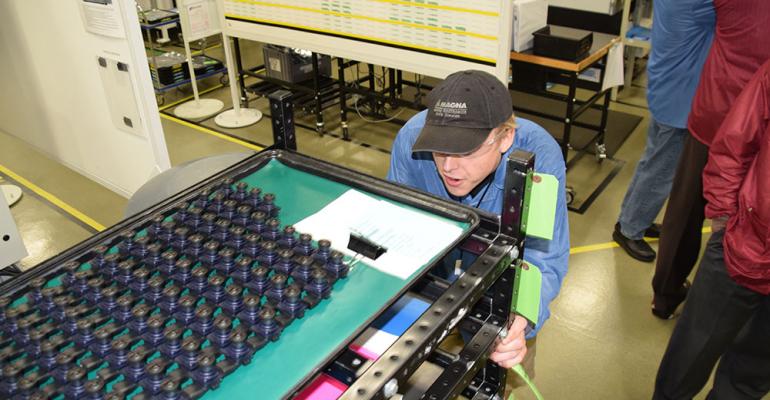HOLLY, MI – Magna’s electronics plant here specializes in rearview backup cameras, but it’s the road ahead that has the Canadian supplier gearing up for a significant boost in volumes.
Since 2005, this facility, along with a second adjacent plant that opened in 2011 to accommodate growth, has churned out 10 million automotive cameras, all of them for rear-facing automotive applications.
But the federal government is requiring improved rear visibility in all new vehicles under 10,000 lbs. (4,536 kg) by 2018, which will force automakers to include rearview cameras as standard equipment after a decade of offering them as optional on many models.
For Magna, the impact will be immense: It took nine years for the plant to produce 10 million cameras, but another 10 million will be assembled within the next 18 months, Steve Allmen, assistant general manager at the facility, tells WardsAuto during a plant tour.
Magna claims leadership in rearview cameras with 45% of the North American market, competing with companies such as Panasonic, Valeo and Robert Bosch, says plant General Manager Jeff Gary.
Production has scaled up gradually, and for about a year output has reached 20,000 cameras daily shipped to 47 OEM locations, primarily in North and South America. The plant serves 15 automaker customers.
Between the two buildings here, with 390 employees, Magna has seven assembly lines requiring three shifts five days a week. Two more lines will be added by year’s end, Gary says.
The plant also has three assembly lines for forward-facing cameras that process more information and can perform many of the functions of today’s radar-based systems that enable adaptive cruise control, collision prevention and automated parking.
Radar sensors have longer range, but forward-facing cameras have a huge advantage, costing a tenth as much, a Magna engineer says.
Globally, Magna claims 27% of the market for forward-facing cameras.
The industry has been expecting rapid growth of rearview cameras since 2008, when Congress passed a law named after Cameron Gulbransen, who died at the age of 2 in a tragic backup accident.
The Department of Transportation was directed to issue a rear-visibility standard by 2011, but the Obama Admin. delayed the rule four times. Initially intended to be in effect for all new vehicles by September 2014, the mandate now is required by 2018.
NHTSA estimates more than 200 fatalities and 15,000 injuries each year are caused by backup crashes in the U.S.
“When the NHTSA ruling originally came out, people started jumping quickly,” Allmen says of customer response. “We were packaged in a lot of vehicles, but the take rates were really low.”
Consumer acceptance eventually drove higher volumes, which resulted in lower prices and availability in affordable, mainstream vehicles.
But the CMOS digital cameras can do much more than provide a view behind the rear bumper. Stereo and mono cameras also are being mounted behind the windshield near the roofline to detect objects a distracted driver might not see. Information from that forward-facing camera can be used to alert the driver or even apply emergency braking.
This technology will play a vital role as self-driving and partially autonomous vehicles advance, requiring cameras or sensors to provide 360-degree vision around a vehicle. Some systems fuse together radar and camera technologies.
“We are seeing a lot more interest in 360-degree systems,” Gary says. “That’s four cameras per vehicle for each 360º system.”
In recent years, Magna Electronics has opened similar camera plants in Germany and China to serve Europe and Asia, respectively. Those plants run at lower volumes but apply production technologies proven out at the facility here.
“We say how to build them, what equipment to use and we provide technical assistance to support them,” Gary says.
Built in 1987, the plant originally assembled circuit boards for electrochromic auto-dimming mirrors.
Whether future growth comes in rear or forward cameras, the plant is ready for additional output.
“We have plenty of room to expand,” Gary says. “From an equipment point of view, we buy it as we need it.”
Throughout the growth phase, plant management is targeting capacity utilization of about 85%, Allmen says.
“We’ve seen the market jump very quickly,” Gary says.
He recalls two years ago when an OEM customer decided suddenly to make backup cameras standard on more of its minivans, effectively boosting the take-rate from 20% to 80%. “We got almost no notice,” he says.


